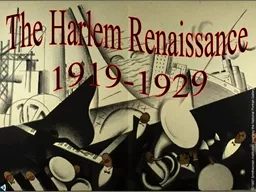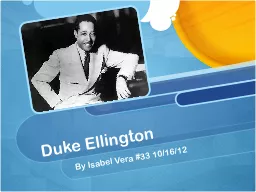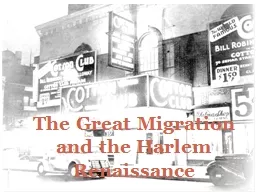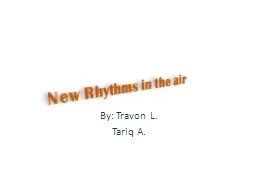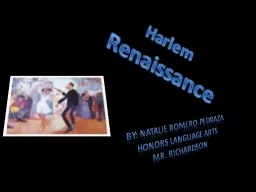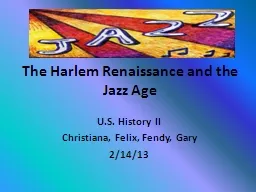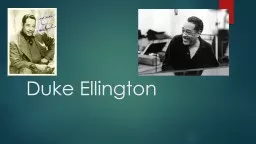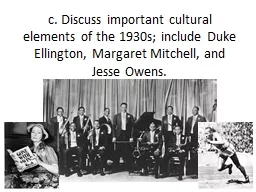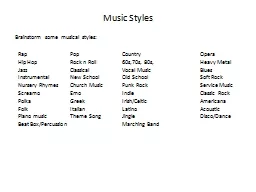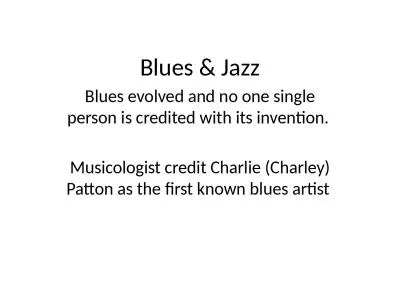PPT-Duke Ellington is memorialized in this statue in Harlem, New York. Ellington was a major
Author : pamella-moone | Published Date : 2019-11-23
Duke Ellington is memorialized in this statue in Harlem New York Ellington was a major presence in the Harlem Renaissance and was famous for playing jazz although
Presentation Embed Code
Download Presentation
Download Presentation The PPT/PDF document "Duke Ellington is memorialized in this ..." is the property of its rightful owner. Permission is granted to download and print the materials on this website for personal, non-commercial use only, and to display it on your personal computer provided you do not modify the materials and that you retain all copyright notices contained in the materials. By downloading content from our website, you accept the terms of this agreement.
Duke Ellington is memorialized in this statue in Harlem, New York. Ellington was a major: Transcript
Duke Ellington is memorialized in this statue in Harlem New York Ellington was a major presence in the Harlem Renaissance and was famous for playing jazz although he played other genres as well classical blues and gospel. During his lifetime Ellington turned musical sounds into many compositions mostly in the style known as jazz The Early Years Edward Kennedy Ellington was born in 1899 in Washing ton DC Given his dislike of piano lessons as a child no one could have By Isabel Vera #33 10/16/12. Date of birth. Edward Kennedy Ellington was born April 29,1899 in the city of Washington, D.C. He was born to Daisy Kennedy Ellington and James Edward Kennedy, both pianist. . I. The Great Migration. Between 1910 and 1920, hundreds of thousands of African-Americans uprooted themselves from their homes in the South to move into the big cities of the North in search of jobs.. By: . Travon. L.. Tariq A.. Music people listen to before 1920 . How did music change during the 1920. People listened to classical music. It changed from signing and actual lyrics to just smooth music. That’s why now some people call jazz “Smooth Jazz”.. Renaissance. By: Natalie Romero-. Pedraza. Honors Language Arts. Mr. Richardson. Quotes. "Those that don't got it, can't show it. Those that got it, can't hide it.“. -. Zora. Neale Hurston. "When peoples care for you and cry for you, they can straighten out your soul.“. A look at their works. Duke Ellington. Jazz Pianist of the Harlem Renaissance. Legendary Jazz Pianist from Washington D.C. who moved to New York in the . 1920s. http. ://. www.biography.com/people/duke-ellington-9286338/videos/duke-ellington-role-in-harlem-renaissance-15037507978. Maroki. . Ms. . Suleyman. . 1. st. hour. 3-21-11. Cab Calloway. Early Life. Cab Calloway was born in 1907 to a middle-class family in Rochester, New York.. When Cab was young, he enjoyed singing in church.. The Great Migration. “Push” Factors:. Reduced opportunities for employment, political participation and better quality of life due to Reconstruction failure and 1896 . Plessy vs. Ferguson. Supreme Court decision. U.S. . History II. Christiana, Felix, Fendy, Gary. 2/14/13. Harlem Renaissance. Harlem Renaissance is the Harlem’s rebirth. Centered in New York’s Harlem district. Made of writers, composers, musicians, artists, entertainers. Successfully combined innovative elements of jazz with the dance band format.. Creative use of instrumental timbres, orchestration, and other compositional devices.. Use of extended and/or complex forms.. King of Ragtime. Born in Texas – moved to St. Louis. Maple Leaf Rag. The Entertainer. A Guest of Honor: Lost first opera. Opera: . Treemonisha. (not staged until 70’s). Died . of syphilis. Maple Leaf Rag. Duke Ellington. Ellington was a composer and was one of the most famous “swing” musicians ever. Swing was a type of dance music which was very popular during the Great Depression.. Ellington and his band traveled all over the world. . Music Styles Brainstorm some musical styles: Rap Pop Country Opera Hip Hop Rock n Roll 60s,70s, 80s, Heavy Metal Jazz Classical Vocal Music Blues Instrumental New School Old School Soft Rock Musicologist credit Charlie (Charley) Patton as the first known blues artist. . The Blues begins to travel. With the success of early blues artist, the blues will begin to spread to other parts of the rural south and across the country developing different regional styles and stars.
Download Document
Here is the link to download the presentation.
"Duke Ellington is memorialized in this statue in Harlem, New York. Ellington was a major"The content belongs to its owner. You may download and print it for personal use, without modification, and keep all copyright notices. By downloading, you agree to these terms.
Related Documents

